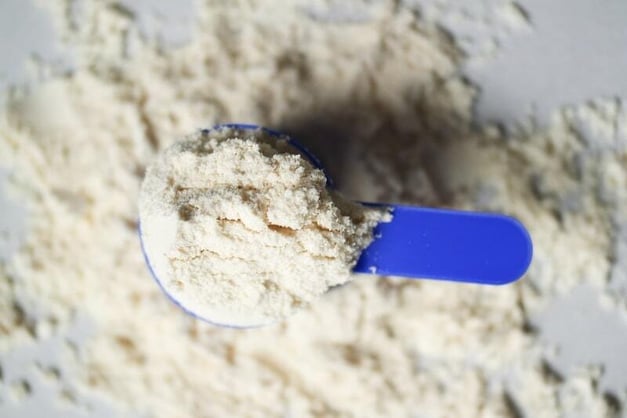The demand for protein powders has surged, fuelled by an increase in sports participation and a growing awareness of health and fitness. Modern consumers are no longer satisfied with generic protein shakes; they seek personalised nutrition tailored to their specific needs, preferences, and dietary restrictions.
This trend has driven manufacturers to innovate and diversify their product lines to meet these specific demands, but with it comes a number of powder handling challenges to overcome.
How Protein Powder is Made
Whey protein powder derives from milk, which is then pasteurised to kill unwanted bacteria. It is then transported to a manufacturing plant where the milk, consisting of 80% casein and 20% whey, is separated through the addition of naturally occurring enzymes. The result is a liquid whey and a solid casein.
The whey is then purified to remove fats, water, and unwanted minerals. It is then dried and any remaining solid particles are separated. This results in a 90% pure whey powder, which is then transported to factories for further processing into protein powders.
It is at this stage that the whey protein is mixed with the desired flavourings and any additional vitamins, minerals and supplements, before being packaged for consumers.
Vegan protein powders are typically made from pea, hemp, brown rice or soy, although other plant-based alternatives are sometimes used. Plant-based protein manufacturing involves extracting, purifying, and drying protein from the raw materials. Similar to whey protein, the end of the process involves blending the protein in powder form with flavourings to product the end product.
Challenges in Protein Manufacturing
While the demand for protein shakes and powders is promising for sports nutrition manufacturers, it brings several challenges.
Allergen Tracing
One of the primary concerns is allergen tracing. With an increasing number of recipes and ingredients, ensuring that there is no cross-contamination between allergenic and non-allergenic products is imperative. This often requires thorough clean-downs between production runs, increasing downtime and reducing efficiency. Containment is also essential to maintain operator safety in the production environment.
Poor-Flowing Powders
Whey protein and plant-based protein are typically sticky and poor-flowing, presenting a challenge in the manufacture of protein powders.

When using butterfly or slide valve bins in your protein manufacturing process, the powders can be prone to 'bridge' upon discharge. This occurs because powder directly above the outlet flows out quickly once the valve is opened. The powder situated above this can bond together, causing a bridge over the outlet. As there is nothing within the bin to break this arch and make it flow, the powder will get stuck.
To address this, operators often need to halt production and manually strike the bin, which can damage equipment over time and cause mix segregation. This common powder handling problem will affect production efficiencies and product quality, increasing costs whilst reducing quality.
Stock Management and Agile Production
Additionally, managing stock build-up can be challenging when dealing with a wide variety of small-batch products. Traditional manufacturing setups are not always agile enough to handle frequent recipe changes without significant downtime, leading to inefficiencies and increased costs. These costs are then reflected in sales prices, reducing your competitive advantage in the sports nutrition industry.
Optimising Production with Matcon's Powder Handling Systems
Matcon’s Intermediate Bulk Container (IBC) systems offer a solution to these challenges. These systems are designed to optimise production flow, minimise manual handling, and enable rapid recipe changeovers. The unique design of Matcon’s IBCs ensures that even the most challenging powders, such as whey protein, are handled efficiently.
By using IBCs, manufacturers can store powders within individual containers, allowing for offline cleaning and reducing downtime. This system also prevents cross-contamination as each batch is fully contained within its IBC, eliminating the need to clean down equipment between different recipes.
The Competitive Edge of Matcon's Cone Valve Technology
The Matcon Cone Valve is an ideal solution for sticky and cohesive powders. It safeguards blend integrity during discharge by creating an annular gap at the IBC outlet, which enables the powder material to flow at the same rate under mass flow. This eliminates dead zones and particle rolling, which in turn prevents powder segregation and bridging, ensuring all material is discharged in a uniform, first-in, first-out sequence.
All of this means you get a perfectly homogenous mix right to the end of the batch, vital to ensure top-quality protein powders and fully satisfied customers.
Future Trends in Protein Powder Manufacturing
As the sports nutrition market continues to evolve, manufacturers must remain agile and innovative. Looking ahead, the integration of automated and modular systems will become increasingly important. These systems will enable manufacturers to scale their operations while maintaining flexibility and efficiency.
By adopting these advanced technologies, manufacturers can stay ahead of the competition and continue to meet the evolving needs of consumers in the sports nutrition market.
Posted by
Matt Baumber
